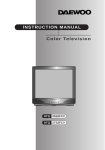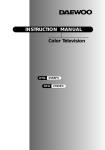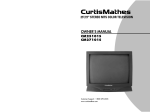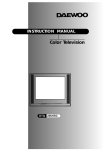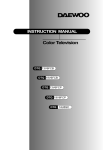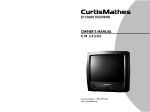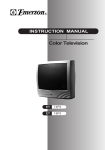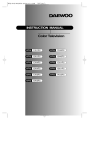Download Daewoo DTQ 21T1 Instruction manual
Transcript
INSTRUCTION MANUAL C o l o r Te l e v i s i o n DTQ 14Q1 DTQ 20T1 DTQ 20Q1 DTQ 21T1 CAUTION RISK OF ELECTRIC SHOCK DO NOT OPEN CAUTION : TO REDUCE THE RISK OF ELECTRIC SHOCK, DO NOT REMOVE COVER (OR BACK) NO USER-SERVICEABLE PARTS INSIDE. REFER SERVICING TO QUALIFIED SERVICE PERSONNEL. The lightning flash with arrowhead symbol, within an equilateral triangle, is intended to alert the user to the presence of uninsulated “dangerous voltage” within the product’s enclosure that may be of sufficient magnitude to constitute a risk electric shock. The exclamation point within an equilateral triangle is intended to alert the user to the presence of important operating and servicing instructions in the literature accompanying the appliance. WARNING TO PREVENT FIRE OR SHOCK HAZARD, DO NOT EXPOSE THIS APPLIANCE TO RAIN OR MOISTURE. CAUTION CHANGES OR MODIFICATIONS NOT EXPRESSLY APPROVED BY THE MANUFACTURER COULD VOID THE USER’S AUTHORITY TO OPERATE THE EQUIPMENT. NOTE TO CATV SYSTEM INSTALLER THIS REMINDER IS PROVIDED TO CALL THE CATV SYSTEM INSTALLER'S ATTENTION TO ARTICLE 820-40 OF THE NEC THAT PROVIDES GUIDELINES FOR PROPER GROUNDING AND, IN PARTICULAR, SPECIFIES THAT THE CABLE GROUND SHALL BE CONNECTED TO THE GROUNDING SYSTEM OF THE BUILDING, AS CLOSE TO THE POINT OF CABLE ENTRY AS PRACTICAL. CONTENTS Table of Contents Important Safeguards Chapter 1: Overview of Your Equipment 2 4 Your TV's Front Panel Your TV's Back Panel Your Remote Control Installing your remote control batteries Notes 4 5 6 7 7 Chapter 2: Connecting an Antenna or Cable to Your TV Connecting an Antenna Connecting a Cable System Connecting Other Pieces of Equipment Safety Note 8 8 9 10 10 Chapter 3: Operating Your TV 11 Turning your TV On Programming Your TV's Channel Memory Changing Channels Changing the Volume Changing The TV's Channel Memory Adding a channel to memory Erasing a channel from memory Changing the TV's channel memory with the menus Changing the TV’s Input Displaying the Current Channel Adjusting Video Settings Returning to factory settings Descriptions of video settings 11 11 13 13 13 13 14 14 15 15 16 17 18 Chapter 4 : Setting the Audio 19 Changing the Sound Mode About AVC About Loudness 19 19 19 Chapter 5: Using Timer Functions 20 Accessing the Timer Menu Setting the Clock Setting the On Timer Setting the Off Timer Canceling the On Timer or Off Timer Setting the Sleep Timer 20 20 21 22 22 23 Chapter 6 : Additional Features 24 Changing the Language of the On-Screen Menus Captioning About captions Power restore Changing the TV’s favorite channel memory with the menus Protection Features Automatic power off Chapter 7 : Troubleshooting Warranty 24 24 25 25 26 26 26 27 28 Table of Contents 1 S A F E T Y IMPORTANT SAFEGUARDS PLEASE READ ALL THESE INSTRUCTIONS REGARDING YOUR TELEVISION EQUIPMENT AND RETAIN FOR FUTURE REFERENCE. FOLLOW ALL WARNINGS AND INSTRUCTIONS MARKED ON THE TV RECEIVER. 1 Read all of these instructions. 2 Save these instructions for later use. 3 Unplug this television equipment from the wall outlet before cleaning. Do not use liquid cleaners or aerosol cleaners. Use a damp cloth for cleaning. 4 Do not use attachments not recommended by the television equipment manufacturer as they may result in the risk of fire, electric shock or other personal injury. 5 Do not use this television equipment near water, for example, near a bathtub, washbowl, kitchen sink, or laundry tub, in a wet basement, or near a swimming pool, or the like. 6 Do not place this television equipment on an unstable cart, stand, or table, The television equipment may fall, causing serious injury to a child or adult, and serious damage to the equipment. Use only with a cart or stand recommended by the manufacturer, or sold with the television equipment. Wall or shelf mounting should follow the manufacturer's instructions, and should use a mounting kit approved by the manufacturer. 6A An appliance and cart combination should be moved with care. Quick stops, excessive force, and uneven surface may cause the appliance and cart combination to overturn. 7 Slots and openings in the cabinet and the back or bottom are provided for ventilation and to ensure reliable operation of the television equipment; and to protect it from overheating, these opening, must not be blocked or covered. The opening should never be blocked by placing the television equipment on a bed, sofa, rug, or other similar surface. (This equipment should never be placed near or over a radiator or heat register.) This television equipment should not be placed in a builtin installation such as a bookcase unless proper ventilation is provided. 8 This television equipment should be operated only from the type of power source indicated on the marking label. If you are not sure of the type of power supplied to your home, consult your television dealer or local power company. 9 This television equipment is equipped with a polarized alternating current line plug (a plug having one blade wider than the other). This plug will fit into the power outlet only one way. This is a safety feature. If you are unable to insert the plug fully into the outlet, try reversing the plug. If the plug should still fail to fit, contact your electrician to replace your obsolete outlet. Do not defeat the safety purpose of the polarized plug. 10 Do not allow anything to rest on the power cord. Do not locate this television equipment where the cord will be abused by persons walking on it. 11 Follow all warnings and instructions marked on the television equipment. 12 For added protection for this television equipment during a lightning storm, or when it is left unattended and unused for long periods of time, unplug it from the wall outlet and disconnect the antenna or cable system. This will prevent damage to the equipment due to lightning and power-line surges. 2 important safeguards 13 An outside antenna system should not be located in the vicinity of overhead power lines or other electric light or power circuits, or where it can fall into such power lines or circuits. When installing an outside antenna system, extreme care should be taken to keep from touching such power lines or circuits as contact with them might be fatal. 14 Do not overload wall outlets and extension cords as this can result in fire or electric shock. 15 Never push objects of any kind into this television equipment through openings as they may touch dangerous voltage points or short-out parts that could result in a fire or electric shock. Never spill liquid of any kind on the television equipment. 16 Do not attempt to service this television equipment yourself as opening or removing covers may expose you to dangerous voltage or other hazards. Refer all servicing to qualified service personnel. 17 Unplug this television equipment from the wall outlet and refer servicing to qualified service personnel under the following conditions: (a) When the power-supply cord or plug is damaged or frayed. (b) If liquid has been spilled, or objects have fallen into the television equipment. (c) If the television equipment has been exposed to rain or water. (d) If the television equipment does not operate normally by following the operating instructions. Adjust only those controls that are covered by the operating instructions as an improper adjustment of other controls may result in damage and will often require extensive work by a qualified technician to restore the TV receiver to its normal operation. (e) If the television equipment has been dropped or the cabinet has been damaged. (f) When the television equipment exhibits a distinct change in performance - this indicates a need for service. 18 When replacement parts are required, be sure the service technician has used replacement parts specified by the manufacturer that have the same characteristics as the original part. Unauthorized substitutions may result in fire, electric shock or other hazards. 19 Upon completion of any service or repairs to this television equipment, ask the service technician to perform safety checks to determine that the television is in a safe operating condition. 20 If an outside antenna or cable system is connected to the television receiver, be sure the antenna or cable system is grounded so as to provided some protection against voltage surges and built-up static charges. Section 810 of the National Electrical Code, ANSI/NFPA N0.70-1984, provides information with respect to proper grounding of the mast and supporting structure, grounding of the lead-in wire to an antenna discharge unit, size of grounding conductors, location of antenna-discharge unit, connection to grounding electrodes, and requirements for the grounding electrode. EXAMPLE OF ANTENNA GROUNDING ANTENNA LEAD IN WIRE GROUND CLAMP ELECTRIC SERVICE EQUIPMENT ANTENNA DISCHARGE UNIT (NEC SECTION 810-20) GROUNDING CONDUCTORS (NEC SECTION 810-20) GROUND CLAMPS NEC-NATIONAL ELECTRICAL CODE POWER SERVICE GROUNDING ELECTRODE SYSTEM (NEC ART 250, PART H) important safeguards 3 CHAPTER 1 Overview of Your Equipment Your TV comes with a remote control. The section below summarizes the buttons, controls, and terminals that you will use with your TV. Your TV's Front Panel 1 POWER Use this button to turn your TV on or off. 2 VIDEO IN jack Use this jack to receive a video signal from another A/V component. 3 AUDIO IN jack DTQ-14/20Q1 use this jack to receive an audio signal from another A/V component. But, DTQ-20/21T1 use this jack to receive audio L/R signal from another A/V component. 4 EARPHONE IN jack Use this jack to receive a audio signal from your TV. 5 STAND-BY (red) indicator This indicator lights up when the power is off. 6 Remote control receiver This receiver receives a signal from your remote control. Don’t block it. 7 WCHV Use these buttons to change channels on your TV, or to select items in the menu system. 8 CVOLB Use these buttons to change your TV’s volume, to activate selections in the menu system, or to change audio and video settings. 9 MENU Use this button to turn the TV’s menu system on and off. DTQ-14/20Q1 ,, ,, POWER VIDEO AUDIO EARPHONE STAND-BY DTQ-20/21T1 POWER 4 VIDEO L AUDIO R EARPHONE STAND-BY Chapter 1 : Overview of Your Equipment ,,, ,,, ,,, ,,, CH VOL MENU CH VOL MENU Your TV’s Back Panel 1 Antenna terminal (ANT) Use this terminal to attach an antenna or cable system to your TV. 2 VIDEO IN This terminal allows the TV to receive a video signal from another component, such as a VCR. 3 AUDIO L/MONO IN This terminal allows the TV to receive an audio L/MONO signal from another component, such as a VCR. 4 AUDIO R IN (This is only DTQ-20/21T1.) This terminal allows the TV to receive an audio R signal from another component, such as a VCR. ,, ,, ,, ,, * DTQ-20/21T1 : Stereo. DTQ-14/20Q1 ANT DTQ-20/21T1 ANT VIDEO AUDIO VIDEO AUDIO L R Chapter 1 : Overview of Your Equipment 5 Your Remote Control 1 POWER Use this button to turn your TV on or off. 2 WCHV Use these buttons to change channels on your TV, or select items in the menu system. 1 3 CVOLB Use these buttons to change your TV's volume, to activate selections in the menu system, or to change audio and video settings. 2 4 MENU 3 3 Use this button to turn the TV's menu system on and off. 4 5 RECALL 2 Press this button to display the channel number. 6 ADD/ERA. 5 6 7 Use this button to add a channel to the TV's memory or erase the channel from memory. 7 MUTE Use to turn the TV's sound on and off. 8 0-9 8 Use these buttons to change channels. 9 SLEEP 9 10 11 13 Use this button to program the TV to turn off after a certain time. 10 PREV. CH Press this button to return to the previous channel you were watching. If you have set Favorite Ch, this key operates to Favorite function. 12 11 TV/VIDEO Use this button to select TV or VIDEO mode. 12 AUTO. PICT Press this button to return the TV's video settings to their original level. 13 AIR/CABLE Use the button to set up your TV to receive signals from an antenna (AIR) or a cable system (CABLE). 6 Chapter 1 : Overview of Your Equipment Installing your remote control batteries 1 Open the battery compartment on the back of the remote control. 2 Install two AAA-size batteries (not included) as shown. Make sure the “+” and “-” terminals are oriented correctly. 3 Replace the cover. 1 2 3 Notes Do not mix different types of batteries, or mix an old and a new battery. Remove and replace weak batteries. Weak batteries can leak and damage your controller. Dispose of batteries properly; never throw them into a fire. Point your remote at the receiver on the center of the front of the TV. Make sure the receiver is not blocked. The remote control can operate up to 30 feet away from the TV, if you are directly facing the front of the TV. Operating distance diminishes as you move to the sides of the TV Chapter 1 : Overview of Your Equipment 7 CHAPTER 2 Connecting an Antenna or Cable to Your TV Your TV will provide you with the best performance if you connect it to an external antenna or cable system. Follow the directions below make this connection. Please note that you will normally only have to make one of the connections shown below, not all of them. All connections will be made to the antenna terminal on the back of your TV. For help in locating the antenna terminal, see “Your TV's Back Panel” on page 5. Connecting an Antenna If your antenna ends in a single coaxial lead, simply press or screw the cable onto the antenna terminal on the back of your TV. If your antenna ends in a pair of 300 ohm twin leads, you must use a 300-ohm/75ohm adaptor. Place the leads underneath the screws on the adaptor, tighten the screws, then press the adaptor onto the antenna terminal on the back of the TV. 8 Chapter 2 : Connecting an Antenna or Cable to Your TV Antennas with two sets of leads You might have two sets of leads from your antenna system, especially if you have one antenna for VHF signals and one antenna for UHF signals. If your antenna system has both a coaxial lead and twin 300-ohm leads, you must obtain a combiner (available at your local electronics store). Press or screw the coaxial lead onto the combiner; place the twin leads underneath the screws on the combiner and tighten the screws. Press the cable from combiner onto the antenna terminal on the back of your TV. If your antenna system has two sets of twin 300-ohm leads, you must obtain a combiner (available at your local electronics store). Place one set of twin leads underneath the screws on the combiner and tighten the screws. Do the same with the other set of twin leads. Press the cable from the combiner onto antenna terminal on the back of your TV. Connecting a cable system If your cable set-up is not described below, please contact your cable company for more information. If your cable system does not require the use of a cable box, simply press or screw the incoming cable onto the antenna terminal on the back your TV. Chapter 2 : Connecting an Antenna or Cable to Your TV 9 If your cable system requires you to use a converter box for all channels, connect the incoming cable to the IN terminal on the converter box. Connect another cable between the OUT terminal on the converter box and the antenna terminal on the TV. You will need to keep your TV tuned to channel 3 or 4 and change channels using the converter box. If your cable system only requires you to use a converter box for some channels (i. e. pay-TV channels), follow these steps: Find the primary incoming coaxial cable. Plug this cable into a splitter (available at your local electronics store). Connect one coaxial cable between one OUT terminal on the splitter and the IN terminal on the converter box. Connect another coaxial cable between the other OUT terminal on the splitter and the B-IN terminal on an A/B switch (available at your local electronics store.) Connect a third coaxial cable between the OUT terminal on the converter box and the A-IN terminal on the A/B switch. Finally, connect a coaxial cable between the OUT terminal on the A/B switch and the antenna terminal on the back of your TV. When the A/B switch is in the A position, you need to change channels on the converter box (and your TV should be tuned to channel 3 or 4); when the A/B switch is in the B position you can change channels on the TV. Connecting Other Pieces of Equipment You may want to connect a VCR, laser disc player, satellite receiver, or another type of equipment to your TV. We recommend that you follow the instructions included with the piece of equipment you wish to connect. Safety Note If you plan on being away from your home for an extended period of time, or if a thunderstorm is approaching, you should unplug your television, and you may wish to disconnect your TV from a rooftop or satellite antenna. You do not need to disconnect your TV from a cable system. 10 Chapter 2 : Connecting an Antenna or Cable to Your TV CHAPTER 3 Operating Your TV Once you have connected your TV to an antenna or cable system, plugged the TV in, and put batteries in the remote, you are ready to use the TV. The first thing you should do is program your TV so it memorizes all of the available channels. Turning Your TV On 1 1 To turn your TV on, press the POWER button on the remote control. You can also use the POWER button on the front panel. Make sure your TV is plugged in before you try to turn it on. Programming Your TV's Channel Memory Your TV's memory determines the channels that are available using the WCHV buttons. If a channel is not in memory, you can tune to it with the number buttons, but not with the WCHV buttons. Follow these steps to program your TV's memory: 1 With the TV turned on, press the MENU button. 2 The only DTQ-20/21T1 is Audio in the menu. 3 Use the WCHV buttons to select Setup, and press the CVOLB buttons. 4 Use the WCHV buttons to select Auto Program, and press the CVOLB buttons. 5 Use the WCHV buttons to select Source, then use the CVOLB buttons to select Air or Cable. 6 If you connected an antenna to your TV, select Air; if you connected a cable system, select Cable. 7 Use the WCHV buttons to select Auto Program, and press the CVOLB buttons to display Auto Program. 8 If you exit Auto Program, press the MENU button. 1 Your TV's channel memory will not be affected by a power outage. You will not need to re-program the memory unless you change the type of cable antenna connected to your TV. 2 3 4 Setup Setup Video Video Audio Audio Timer Timer LPrev WVMove CBSelect LPrev WVMove CBSelect Setup Auto Program Edit Program Favorite Ch Language Captions Power Restore Input CBTo Press L Prev WVSelect CBAdjust Chapter 3 : Operating Your TV 11 5 6 Auto Prog. Source Auto Program Air Source Auto Program L Prev WVSelect CBAdjust 7 Auto Prog. Cable L Prev WVSelect CBAdjust 8 Auto Prog. XX Program Source Auto Program CBTo Program L Prev WVSelect CBAdjust 9 12 Chapter 3 : Operating Your TV L Stop Changing Channels You can change channels in three ways: 1 The WCHV buttons will take you through all memorized channels, one by one. The WCHV buttons will not access channels that have not been programmed into the TV's memory. For more information about programming channels into memory, see the section “Programming your TV's Channel Memory,” above. 1 2 3 2 The number buttons (0-9) will take you to any channel, even if it has not been memorized. To change to a channel, enter its number; the TV will tune to the new channel when you enter the second digit of the channel. 3 The PREV. CH button will take you instantly to the favorite channel it was in memory. Changing the Volume 1 2 1 To change the volume of the TV set, use the CVOLB buttons on the remote or on the front panel. 2 To quickly turn off the sound, press the MUTE button on the remote. To return the volume to its previous level, press the MUTE button again. Changing the TV's Channel Memory Your TV's memory determines the channels that are available using the WCHV buttons. You can add channels to this memory or remove them from memory. If a channel is removed from memory, you can tune to it with the number buttons, but you cannot tune to it with the WCHV buttons. Adding a channel to memory 1 2 1 Use the number buttons to tune to the channel. 2 Press the ADD/ERA button on the remote control. The channel will turn from red to white to show it has been added. Chapter 3 : Operating Your TV 13 Erasing a channel from memory 1 2 1 Tune to the channel you want to erase. 2 Press the ADD/ERA button on the remote control. The channel will turn from white to red to show it has been erased. Changing the TV's channel memory with the menus You can also use the menu system to add or erase channels from memory: 1 Use the number buttons to tune to the channel, then press the MENU button. 2 Use the WCHV buttons to select Setup and press the CVOLB buttons. 3 Use the WCHV buttons to select Edit Program and press the CVOLB buttons. If the channel is in memory, it will be labeled “Added”, and the number in the corner will be white. If the channel is not in memory, it will labeled “Erased”, and the number in the corner will be red. 4 Use the CVOLB buttons to change the Added or Erased setting. 5 Wait 10 seconds, or press the MENU button twice to exit. 1 2 3 Setup Video Audio Timer L Prev WVMove CBSelect 4 Ch 13 Added L Prev WVCh CBErase 14 Chapter 3 : Operating Your TV 5 Setup Auto Program Edit Program Favorite Ch Language Captions Power Restore Input Ch 13 Erased L Prev WVCh CBAdd CBTo Press L Prev WVSelect CBAdjust 6 Changing the TV’s Input Normally, your TV displays the signal coming through the antenna terminal. However, if you’ve connected another component to your TV (such as a VCR) using the Audio/Video Inputs, you will want to be able to view the signal from that component. To do this, you will need to switch from the “TV” input to the “Video” input, as follows; 1 With the TV turned on, Press MENU 2 You will see the Main Menu, Use the WCHV buttons to select Setup and press the CVOLB buttons. 3 Use the WCHV buttons to select Input. 4 Press the CVOLB buttons to change from TV to VIDEO. Press the CVOLB buttons again to switch back to TV. 5 Wait 10 seconds to return to normal viewing, or press the MENU button twice. The only DTQ-20/21T1 had to notice as follow: When it connected an audio cable from the AUDIO out jack on the VCR to the AUDIO jack on the front your TV and your TV’s back panel at the same time, the former takes precedence of the latter. If it received an audio mono signal from another component, such as a VCR at this time, we must connect an audio Y cable from the AUDIO out jack on the VCR to the AUDIO jack on the front your TV. Equipment with Mono sound Output Displaying the Current Channel 1 1 To quickly see the current channel, press RECALL. The current channel will be displayed briefly. Chapter 3 : Operating Your TV 15 Adjusting Video Settings You may wish to adjust the video settings (e. g. contrast or color) to obtain the most pleasing picture. To do so, follow these directions: 1 With the TV turned on, press the MENU button. 2 Use the WCHV buttons to select Video. 3 Press the CVOLB buttons. The video menu will appear. 4 Use the WCHV buttons to select the video setting you wish to adjust. Descriptions of the video settings are on the next page. 1 2 3 4 Setup Video Video Picture Pref. Contrast Brightness Sharpness Color Tint Audio Timer L Prev WVMoveCBSelect Video Preset L Prev WVSelect CBAdjust Picture Pref. Contrast Brightness Sharpness Color Tint - |||||| – – – + |||| – – – – |||| – – – – |||| – – – – G–––I–––R L Prev WVSelect CBAdjust 5 Use the CVOLB buttons to adjust the video setting to the level you prefer. 6 Use the WCHV buttons to select another video setting to adjust. 7 When you are finished, press the MENU button twice to return to normal viewing. 5 6 Video Picture Pref Contrast Brightness Sharpness Color Tint - |||||| – – – + L Prev WVSelect CBAdjust 16 7 Video Chapter 3 : Operating Your TV Picture Pref Contrast Brightness Sharpness Color Tint - |||||| – – – + L Prev WVSelect CBAdjust Returning to the factory settings If you would like to return to the original video settings, as they were calibrated at the factory, follow these steps : 1 Follow steps 1-3 in “Adjusting Video Settings” on the previous page. 2 Use the WCHV buttons to select Picture Pref. 3 Press the CVOLB buttons to set to Preset and Custom. These will return all video settings to their default level, as set at the factory. 4 Wait 10 seconds, or press the MENU button twice to exit. 1 2 Video Picture Pref. Contrast Brightness Sharpness Color Tint 3 Video Preset Picture Pref. Contrast Brightness Sharpness Color Tint L Prev WVSelect CBAdjust Custom L Prev WVSelect CBAdjust If you set to Preset and Custom in direct mode, Use the AUTO. PICT button, follow these step: 1 Press the AUTO. PICT button. 2 Press the AUTO. PICT button to set to Preset or Custom. 3 Wait 3 seconds to exit. 1 Picture Pref. Custom Preset Chapter 3 : Operating Your TV 17 Descriptions of video settings The contrast setting controls the relation between the light and black areas of the screen. If the light areas are too bright and are losing details, adjust the contrast towards the “-” position; if the picture is gray and lacks contrast, adjust the contrast towards the “+” position. The brightness settings controls the overall amount of light in the picture. If the picture is too bright, adjust the brightness setting towards the “-” position; if the picture is too dark, adjust the brightness towards the “+” position. Sharpness controls how the TV displays edges of objects on-screen. If the TV shows multiple vertical lines at the edges of an object, adjust sharpness towards the “-” position; if the vertical edges of on-screen objects are fuzzy, adjust sharpness towards the “+” position. The color setting controls the intensity of color. If the color is over-saturated, adjust the color towards the “-” position; if the color is washed out, adjust the color towards the “+” position. The tint setting controls the relationship of red and green in a picture. Tint is especially noticeable in flesh tones. If flesh tones seem too red or purple, adjust the color towards “G”; if the flesh tones are too green, adjust the color towards “R”. 18 Chapter 3 : Operating Your TV CHAPTER 4 Setting the Audio (This is only DTQ-20/21T1) Your TV set is capable of decoding a Stereo signal. Changing The Sound Mode 1 Press the MENU button, Use the WCHV buttons to select Audio. 2 Press the CVOLB buttons. The Audio menu be displayed. 3 Use the WCHV buttons to select Audio Mode and press the CVOLB buttons to change the Stereo or SAP, Mono. 4 Use the WCHV buttons to select AVC, press the CVOLB buttons. 5 Use the WCHV buttons to select Loudness, press the CVOLB buttons. 6 Wait 10 seconds, or press the MENU button twice to exit. 1 2 3 Audio Setup Video Audio Mode AVC Loudness Audio Timer L Prev WVMove CBSelect 4 Audio Mode AVC Loudness L Prev WVSelect CBAdjust 6 5 Audio Stereo Audio On L Prev WVSelect CBAdjust Audio Mode AVC Loudness On L Prev WVSelect CBAdjust About AVC This performs an Automatic Volume Control Function. The sound signal conditions coming out of TV stations are different from each other. Some signals are intense and others are not intense enough. When the AVC is on, uniform sound can be ensured regardless of the conditions of TV stations. About Loudness This is a special effect, or also named as ‘3D Effect’. This emphasizes high-pitched and low-pitched ranges of the sound. This makes the sound magnificent. When the Loudness is on, a movie or music sounds very splendid. Chapter 4 : Setting the Sound 19 CHAPTER 5 Using Timer Functions Your TV has a built in-clock, and you can set the TV to turn on and off at times that you select. You can also set your TV to turn off after counting down a certain amount of time. Accessing the Timer Menu 1 2 3 4 With the TV turned on, press the MENU button. Use the WCHV buttons to select TIMER. Press the CVOLB buttons. The TIMER menu will be displayed. Wait 10 seconds, or press the MENU button twice to exit. 1 2 3 4 Timer Setup Video Clock On Time Off Time Sleep Audio Timer L Prev WVMove CBSelect 01:00 AM 12:35 AM 12:34 AM 11:05 PM L Prev WVSelect CBAdjust Setting the Clock 1 Follow steps 1-3 in “Accessing the Timer Menu,” above. 2 Press WCHV buttons to select Clock. 3 Press the CVOL button to set the hours (including AM/PM); press the VOLB button to set the minutes. If you hold down either VOL button, the corresponding numbers will change more quickly. 4 When the clock is set correctly, use the WCHV buttons to select another timer function, or use the MENU button to exit this menu. 5 Wait 10 seconds, or press the MENU button twice to exit. 1 2 3 Timer Clock On Time Off Time Sleep Timer 01:00 AM L Prev WVSelect CBAdjust 20 Clock On Time Off Time Sleep Timer 01:00 AM L Prev WVSelect CBAdjust Chapter 5 : Using Timer Functions Clock On Time Off Time Sleep 01:00 AM L Prev WVSelect CBAdjust 4 Setting the On Timer If you enter a time in the On Time setting, your TV will automatically turn on at that time. Follow these instructions to set the On Time: 1 Follow steps 1-3 in “Accessing the Timer Menu” on the previous page. 2 Use the WCHV buttons to select On Time. 3 Press the CVOL button to set the hours (including AM/PM); press the VOLB button to set the minutes. If you hold down either VOL button, the corresponding numbers will change more quickly. 4 When the setting is correct, use the WCHV buttons to select another timer function, or use the MENU button to exit this menu. 5 Wait 10 seconds, or press the MENU button twice to exit. 1 2 Timer Clock On Time Off Time Sleep 3 Timer 12:35 AM L Prev WVSelect CBAdjust Clock On Time Off Time Sleep Timer 12:35 AM L Prev WVSelect CBAdjust Clock On Time Off Time Sleep 12:35 AM L Prev WVSelect CBAdjust Chapter 5 : Using Timer Functions 21 4 Setting the Off Timer If you enter a time in the Off Time setting, your TV will automatically turn off at that time. Follow these instructions to set the Off Time: 1 Follow steps 1-3 in “Accessing the Timer Menu” on the previous page. 2 Use the WCHV buttons to select Off Time. 3 Press the CVOL button to set the hours (including AM/PM); press the VOLB button to set the minutes. If you hold down either VOL button, the corresponding numbers will change more quickly. 4 When the setting is correct, use the WCHV buttons to select another timer function, or use the MENU button to exit this menu. 5 Wait 10 seconds, or press the MENU button twice to exit. 1 2 Timer Clock On Time Off Time Sleep 4 3 Timer 12:34 AM L Prev WVSelect CBAdjust Clock On Time Off Time Sleep Timer 12:34 AM L Prev WVSelect CBAdjust Clock On Time Off Time Sleep 12:34 AM L Prev WVSelect CBAdjust Canceling the On Timer or Off Timer If you would like to cancel the On Timer or the Off Timer, press the CVOLB buttons until the timer settings return to “- -:- -” (in Magenta). The On Timer and Off Timer will not function correctly unless the clock has been set. 22 Chapter 5 : Using Timer Functions Setting the Sleep Timer The sleep timer allows you to set an amount of time from 15 minutes to 4 hours; the TV will count down the amount of time you set, then turn itself off. To set the sleep timer: 1 Follow steps 1-3 in “Accessing the Timer Menu.” 2 Use the WCHV buttons to select sleep. 3 Use the CVOLB buttons to set the sleep time. Each time you press VOL, you step between the available sleep times: 0:00, 0:15, 0:30, 0:45, 1:00, 1:30, 2:00, 2:30, 3:00, 3:30, 4:00. 4 When the setting is correct, use the WCHV buttons to select another timer function, or use the MENU button to exit this menu. 5 You can also set the Sleep timer during normal TV viewing, simply by pressing the Sleep button on the remote control. This button steps through the available sleep times (see step 2), one by one. 6 Wait 10 seconds, or press the MENU button twice to exit. To cancel the sleep timer, turn the TV off, or set the sleep time to “0” using one of the methods described above. 1 2 Timer Clock On Time Off Time Sleep 3 Timer Clock On Time Off Time Sleep 0:00 L Prev WVSelect CBAdjust Timer Clock On Time Off Time Sleep 0:00 L Prev WVSelect CBAdjust 0:00 L Prev WVSelect CBAdjust 5 4 Sleep Timer 0:00 Chapter 5 : Using Timer Functions 23 CHAPTER 6 Additional Features This section contains descriptions of the more advanced features of your TV. Changing the Language of the On-screen Menus You can choose to display the on-screen menus in English, Spanish, or French. To change the on-screen language: 1 With the TV turned on, press the MENU button. 2 Use the WCHV buttons to select Setup, press the CVOLB buttons. 3 Use the WCHV buttons to select Language. 4 Use the CVOLB buttons to select the language you want to use : English (ENG), Spanish (ESP), or French (FRA). 5 Wait 10 seconds, or press the MENU button twice to return to normal TV viewing. 1 2 3 Setup Video Audio Timer L Prev WVMove CBSelect 4 Setup Auto Program Edit Program Favorite Ch Language Captions Power Restore Input English L Prev WVSelect CBAdjust Captioning Many TV shows contain “closed captions”. These captions are hidden words that can be displayed on your TV screen. There are two types of these words : “captions” usually follow the action on-screen, providing a written version of the dialogue, narration, and sound effects ; “text” is not usually related to the action on-screen, often providing information such as news or weather. A TV program might be providing more than one set of captions. To set your TV to display captions. 1 With the TV turned on, press the MENU button. 2 Use the WCHV buttons to select Setup, press CVOLB buttons. 3 Use the WCHV buttons to select Captions. 24 Chapter 6 : Additional Features 4 To turn captioning on, use the CVOLB buttons to select captions (Caption 1, Caption 2). At the time these instructions were written, only Caption is normally available, but feel free to try other selections. 5 Wait 10 seconds, or press the MENU button twice to return to normal TV viewing. Your setting will remain intact until you change it. 1 2 3 Setup Video Audio Timer L Prev WVMove CBSelect 4 Setup Auto Program Edit Program Favorite Ch Language Captions Power Restore Input Off L Prev WVSelect CBAdjust About caption Once you have chosen a caption setting, all available captions on that setting will be displayed when you watch TV. If no captions appear, it is because there are no captions being broadcast for that show. Look for a “CC” mark in the TV listings or on video tapes. This mark indicates that captions are provided for that program. Please note : The content and appearance of captions are determined by the broadcaster, not by the TV. If the captions display strange characters, misspellings, or odd words, those errors are made by the broadcaster, not your TV. Errors in captioning are more common during live programs than during taped programs. Your TV cannot display captions when it is displaying any other on-screen information. If you use the RECALL or VOL buttons, the captions will briefly disappear. Power Restore. 1 With the TV turned on, press the MENU button. 2 Use the WCHV buttons to select Setup, press CVOLB buttons. 3 Use the WCHV buttons to select Power Restore, then press the CVOLB buttons. 4 Wait 10 seconds, or press the MENU button twice to exit. This is the function for turning on/off TV using AC POWER and is usually used for convenience’ sake in display areas or in department stores. This function is rarely used for domestic use, so special care is needed while using. Chapter 6 : Additional Features 25 1 2 3 Setup Video Auto Program Edit Program Favorite Ch Language Captions Power Restore Input Audio Timer L Prev WVMove CBSelect 4 Setup Off L Prev WVSelect CBAdjust Changing the TV’s favorite channel memory with the menus. You can also use the menu system to be On or Off favorite channels from memory. 1 With the TV turned on, press the MENU button. 2. Use the WCHV buttons to select Setup, press CVOLBbuttons. 3. Use the WCHV buttons to select Favorite Ch, then press the CVOLB buttons. 4. Use the CVOLB buttons to select Favorite or Normal. If the favorite channel is in memory, it will be labeled “Favorite”, and this will be the number in the corner. If the favorite channel is not in memory, it will labeled “Normal”, and this will be with the number in the corner. 5. Use the CVOLB buttons to change the Favorite or Normal setting. 6. Wait 10 seconds, or press the MENU button twice to exit. 1 2 Setup Video Audio Timer L Prev WVMove CBSelect 3 Setup Auto Program Edit Program Favorite Ch Language Captions Power Restore Input Ch 13 Favorite 4 Ch 13 Normal CBTo Press L Prev WVSelect CBAdjust L Prev WVCh CBNormal L Prev WVCh CBFavorite protection Features The following two features protect your TV from operating unnecessarily. Automatic power off If your television does not receive a television signal for 15 minutes, it will automatically turn off. 26 Chapter 6 : Additional Features CHAPTER 7 Troubleshooting Your Daewoo television is designed to give you trouble-free performance for many years. If you have a problem with your TV, try the solutions listed below. If the suggestions listed below do not solve your problem, contact your Daewoo dealer or an authorized Daewoo service center. There is no picture or sound, or the TV won't turn on. • • • • Make sure the TV is plugged in. Make sure the MUTE is not set. Make sure the power is on. If there is neither picture or sound, unplug the TV for 30 seconds, then plug it in and try again. There is no picture or sound on some UHF channels. • Try another station. If the other stations are OK, it may be a station problem. • Check that the antenna is connected, is in good working order, has no broken wires, and is adjusted correctly. • See if anything is interfering with the antenna signal. • Make sure the Air/Cable setting is correct. The sound is OK, but the picture is poor. • Try another station. If the other stations are OK, it may be a station problem. • Check that the antenna is connected and is in good working order, has no broken wires, and is adjusted correctly. The picture is OK, but the sound is poor. • Try another station. If the other stations are OK, it may be a station problem. • Check that the antenna is connected, is in good working order, has no broken wires, and adjusted correctly. There is poor reception on some channels. • Try another station. If the other stations are OK, it may be a station problem. • Check that the antenna is connected, is in good working order, has no broken wires, and is adjusted correctly. You cannot tune to a cable channel. • Make sure the Air/Cable setting is correct. • The channel may not be programmed into memory. The picture rolls, slants, shows lines, is grainy, has poor color, or has ghosts. • Try another station. If the other station are OK, it may be a station problem. • Check that the antenna is connected, is in good working order, has no broken wires, and is adjusted correctly. • See of anything is interfering with the antenna signal. The remote control does not work. • Make sure the TV is plugged in. • Make sure there are fresh batteries in the remote control. • Make sure there is nothing blocking the remote control signal. Chapter 7 : Troubleshooting 27 WARRANTY Warranty Daewoo Electronics Co., LTD. warrants each new electronic product manufactured by it to be free from defective material and workmanship and agrees to remedy any such defect or to furnish a new part (at the Company’s option) in exchange for any part of any unit of its manufacture which under normal installation, use, and service disclosed such defect, provided the unit is delivered by the owner to us or to our authorized distributor from whom purchased the unit is delivered by the owner to us or to our authorized distributor from whom purchased or authorized service station, intact, for our examination with all transportation charges prepaid to our factory. To establish and receive warranty service at our factory or authorized service facilities, proof of purchase/dated sales invoice is required Return authorization must be obtained before any merchandise is returned to the factory. This warranty does not extend to any of our electronic products which have been subjected to misuse, neglect, accident, incorrect wiring not our own, improper installation, unauthorized modification, or to use in violation of instructions furnished by us, nor units which have been repaired or altered outside of our factory, nor to cases where the serial number thereof has been removed, defaced, or changed. This warranty is in lieu of all warranties expressed or implied and no representative or person is authorized to assume for us any other liability in connection with the sake of our electronic products. Over-the-counter exchange for units that are initially defective “Initially defective” is described as when the dealer opens the unit and finds that it is inoperative or a customer opens a new unit and finds that it is inoperable. This unit may be returned to the factory by the dealer for exchange. Under no circumstances will the customer be permitted to return the defective unit directly to the factory. Exchange must be directly with the dealer. Model DTQ-14/20Q1 DTQ-20/21T1 28 Warranty Parts 1 year 1 year Labor 1year 1year Picture Tube 2years 2years P/N:48586201E101

































